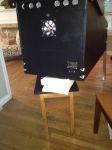Hi, this is my build diary.
I started this project back in March 2013. Originally, I was going to retrofit an empty cabinet. I found a suitable one close by with a BSD that had been stripped to wood, rails, and a coin door. It otherwise still looked pretty nice. But the seller had broken it down and wasn’t sure that he still had the backbox. Even now he is still advertising it. If you are a local to Austin, TX it might work for a project. It’s kind of pricey but he was willing to negotiate.
http://www.pinballme..._cab/index.html
At that time, I became intrigued with the Pinball 2000 design. I liked that the display was configurable in terms of color and size. And that it was future proofed for the time when there might be games with full color displays available: Pro Pinball Fantastic Journey, WOZ, or even RFM or SW1 if any of these ever see the light of day. There is at least one reproduction built specifically for Pinball 2000 style cabinets, United Chief Shuffle Alley Bowler available at the other forum.
I took the plunge with Brad at VPCabs as the builder on a basic Pinball 2000 style cabinet. I’m glad I did. I had a little more money than time. As it turns out, I got real busy. If I had tried to do the build myself, I don’t think I would have gotten anywhere. But instead I got a great cabinet. VP and HP run very well. No problems with stuttering on even demanding tables with v9.1.5. Further details and specs can be found at VPCabs.com and here:
http://www.hyperspin...ll=1#post255643
What this topic is about is taking the basic machine and pimping it out to be sweet ass and fabulous - Further enhancing user configurability that can allow for closer reproduction of actual machines (at least in sprit) and also for cool sound effects and lightshows. The arrival of DOF inspired a blow-out on toys and other outputs using authentic pinball parts.
Some highlights:
Best of all worlds approach to DMD: retaining the third display reflecting onto the playfield but adding swappable DMD toppers designed and cut by Greg at XTremePinball.com. The same producer of cabinets for VPCabs. Each topper has an array of five new Cree RGBW LEDs, each color capable of being driven at 1,000 mA.
Topper 1 – OEM high voltage Vishay Plasma
Topper 2 – new white LED display from XPin which includes from the manufacturer 9 different color vinyl gels (but can use any color gel to project any color)
Functionally, either can be used as a top mounted display similar to this:
http://www.bostonpin...pany.com/gd.htm
Or with the XDMD API it might possibly be used similar to a Beta Brite tournament sign
https://www.youtube....h?v=xwm-QexU2oc
Art-Net/DMX driven fixtures using DOF under cab and behind the back box:
2 800W Xenon strobes
2 RGB panels each with 96 red, 96 blue, 96 green LEDs driven in a 4x2 matrix
Front panel lighting:
nine individually controllable RGB LED buttons – L MagnoSave, L Flipper, Start, Extra Ball. L coin reject, R coin reject, Launch Ball, R Flipper, R MagnoSave
Playfield flashers:
new array of five Cree RGBW LEDs, each color capable of being driven at 1,000 mA
Analog nudging:
VirtuaPin Digital Plunger Kit.
Tilt:
detected by a used tilt assembly pulled from an early 80’s Williams SS (Black Knight, Jungle Lord) which includes a plumb bob and tilt ball trough. Tilt also detected with OEM coin door slam switches.
Coin door:
coin door open detected using an OEM memory interlock switch assembly.
coin door includes OEM service button assembly
Sound Effects:
tilt assembly mentioned earlier includes a 4 inch bell assembly and a knocker assembly
for reproducing 60’s era EMs or earlier – Gottlieb 3” 1 point bell, Gottlieb 3” 10 point bell, and Gottlieb (or Williams) 5” 100 point bell
for reproducing 70’s era EMs (or DE Time Machine or prototype Tommy mod) – 2 Gottlieb chime units. I will mod one of the chime units to use custom tone bars that I will cut myself
NOS Captain Fantastic “over-the-top” buzzer
set of used EM relays and score reel motors
Force feedback:
Zeb’s shaker/motor combo and 10 Siemens contactors using the washer mod
I will maintain my build sheet here with my costs and sources:
https://dl.dropboxus... Build List.pdf
As I am sharing tools and materials with my simultaneous arcade/MAME/HyperSpin build, all of the costs for the entire endeavor are here. The highlighted items are items that I purchased, but I’m not sure that I will use them by the end.
I’ve sourced nearly all items for the build. I’m just getting started with the installation. It will be a challenge. I don’t really have any experience with woodworking. I haven’t studied a circuit since high school. But it will be a learning experience, and I may even have some new information gleaned from my research to relay in future posts over the next few weeks/months.
Special thanks:
Suppliers to the virtual pinball community – mameman (mameman23), Noah, RandyT of GroovyGameGear, russdx, shakenbake, and zebulon
All of the VP and VPinMAME developers, table authors, and suppliers of ROMs and graphic resources past and present
Swisslizard for DOF
Suppliers of OEM and licensed reproduction parts that keep the real machines running and lend some measure of authenticity to our virtual builds – K’s Arcade, Marco Specialties, Pinball Life, and The Pinball Resource
And for inspiration – antropus, arngrim, bent98, bill55, Gamester, randr, RoccoC, and dozens of others whose builds I’ve looked at VP Forums and HyperSpin forums over the last few months.






 Top
Top












































 are all trademarks of VPFORUMS.
are all trademarks of VPFORUMS.